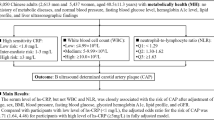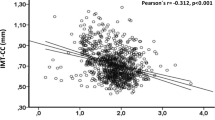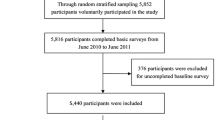Abstract
Background
Obesity and metabolic syndrome (MetS) have been acknowledged to commonly co-exist and lead to increased risks of stroke, whereas the association between various BMI-based metabolic phenotypes and development of intracranial atherosclerotic stenosis (ICAS) remained controversial.
Methods
A total of 5355 participants were included from the Asymptomatic Polyvascular Abnormalities Community (APAC) study. Participants were categorized into six groups according to their body mass index (BMI) and MetS status. ICAS was assessed using transcranial Doppler (TCD) Ultrasonography. Logistic regression was employed to evaluate the association between BMI-based metabolic phenotypes and ICAS.
Results
704 participants were diagnosed with ICAS. Compared to the metabolic healthy normal weight (MH-NW) group, the metabolic unhealthy normal weight (MUH-NW) group demonstrated a higher risk of ICAS (full-adjusted odds ratio [OR], 1.91; 95% confidence interval [CI], 1.42–2.57), while no significant association was observed in the metabolic unhealthy obesity (MUO) group (full-adjusted OR, 1.07; 95% CI, 0.70–1.65) and other metabolic healthy groups regardless of BMI. The results were consistent across gender, age, smoking, alcohol intake, and physical activity subgroups.
Conclusion
The present study suggested that MUH-NW individuals had a significant association with increased risk of ICAS compared with MH-NW individuals.
This is a preview of subscription content, access via your institution
Access options
Subscribe to this journal
Receive 12 print issues and online access
$259.00 per year
only $21.58 per issue
Buy this article
- Purchase on Springer Link
- Instant access to full article PDF
Prices may be subject to local taxes which are calculated during checkout

Similar content being viewed by others
Data availability
The datasets used and/or analyzed during the current study are available from the corresponding author upon reasonable request.
References
Aune D, Sen A, Norat T, Janszky I, Romundstad P, Tonstad S, et al. Body Mass Index, Abdominal Fatness, and Heart Failure Incidence and Mortality: A Systematic Review and Dose-Response Meta-Analysis of Prospective Studies. Circulation. 2016;133:639–49.
Collaboration NCDRF. Trends in adult body-mass index in 200 countries from 1975 to 2014: a pooled analysis of 1698 population-based measurement studies with 19·2 million participants. Lancet. 2016;387:1377–96.
Mongraw-Chaffin M, Foster MC, Kalyani RR, Vaidya D, Burke GL, Woodward M, et al. Obesity Severity and Duration Are Associated With Incident Metabolic Syndrome: Evidence Against Metabolically Healthy Obesity From the Multi-Ethnic Study of Atherosclerosis. J Clin Endocrinol Metab. 2016;101:4117–24.
Mottillo S, Filion KB, Genest J, Joseph L, Pilote L, Poirier P, et al. The metabolic syndrome and cardiovascular risk a systematic review and meta-analysis. J Am Coll Cardiol. 2010;56:1113–32.
Poirier P, Giles TD, Bray GA, Hong Y, Stern JS, Pi-Sunyer FX, et al. Obesity and cardiovascular disease: pathophysiology, evaluation, and effect of weight loss: an update of the 1997 American Heart Association Scientific Statement on Obesity and Heart Disease from the Obesity Committee of the Council on Nutrition, Physical Activity, and Metabolism. Circulation. 2006;113:898–918.
Finucane MM, Stevens GA, Cowan MJ, Danaei G, Lin JK, Paciorek CJ, et al. National, regional, and global trends in body-mass index since 1980: systematic analysis of health examination surveys and epidemiological studies with 960 country-years and 9·1 million participants. Lancet. 2011;377:557–67.
Eckel RH, Grundy SM, Zimmet PZ. The metabolic syndrome. Lancet. 2005;365:1415–28.
Ma YH, Leng XY, Dong Y, Xu W, Cao XP, Ji X, et al. Risk factors for intracranial atherosclerosis: A systematic review and meta-analysis. Atherosclerosis. 2019;281:71–7.
Liu L, Shi Z, Ji X, Zhang W, Luan J, Zahr T, et al. Adipokines, adiposity, and atherosclerosis. Cell Mol Life Sci. 2022;79:272.
White H, Boden-Albala B, Wang C, Elkind MS, Rundek T, Wright CB, et al. Ischemic stroke subtype incidence among whites, blacks, and Hispanics: the Northern Manhattan Study. Circulation. 2005;111:1327–31.
Wong LK. Global burden of intracranial atherosclerosis. Int J Stroke. 2006;1:158–9.
Wang Y, Zhao X, Liu L, Soo YO, Pu Y, Pan Y, et al. Prevalence and outcomes of symptomatic intracranial large artery stenoses and occlusions in China: the Chinese Intracranial Atherosclerosis (CICAS) Study. Stroke. 2014;45:663–9.
Wang A, Wu J, Zhou Y, Guo X, Luo Y, Wu S, et al. Measures of adiposity and risk of stroke in China: a result from the Kailuan study. PLoS One. 2013;8:e61665.
Zhou Y, Li Y, Xu L, Xu J, Wang A, Gao X, et al. Asymptomatic polyvascular abnormalities in community (APAC) study in China: objectives, design and baseline characteristics. PLoS One. 2013;8:e84685.
Fan C, Zhang Q, Zhang S, Wang A, Bi X, Chen S, et al. Association of Newly Found Asymptomatic Intracranial Artery Stenosis and Ideal Cardiovascular Health Metrics in Chinese Community Population. Sci Rep. 2020;10:7200.
WHO Consultation on Obesity (1999: Geneva, Switzerland) & WorldHealth Organization. Obesity: preventing and managing the global epidemic: report of a WHO consultation. World Health Organization; 2000. https://iris.who.int/handle/10665/42330.
Alberti KG, Eckel RH, Grundy SM, Zimmet PZ, Cleeman JI, Donato KA, et al. Harmonizing the metabolic syndrome: a joint interim statement of the International Diabetes Federation Task Force on Epidemiology and Prevention; National Heart, Lung, and Blood Institute; American Heart Association; World Heart Federation; International Atherosclerosis Society; and International Association for the Study of Obesity. Circulation. 2009;120:1640–5.
Chen C, Lu FC. The guidelines for prevention and control of overweight and obesity in Chinese adults. Biomed Environ Sci. 2004;17:1–36.
Hinnouho GM, Czernichow S, Dugravot A, Batty GD, Kivimaki M, Singh-Manoux A. Metabolically healthy obesity and risk of mortality: does the definition of metabolic health matter? Diabetes Care. 2013;36:2294–300.
Carmelli D, Swan GE, Bliwise DL. Relationship of 30-year changes in obesity to sleep-disordered breathing in the Western Collaborative Group Study. Obes Res. 2000;8:632–7.
Kramer H, Gutierrez OM, Judd SE, Muntner P, Warnock DG, Tanner RM, et al. Waist Circumference, Body Mass Index, and ESRD in the REGARDS (Reasons for Geographic and Racial Differences in Stroke) Study. Am J Kidney Dis. 2016;67:62–9.
Fan J, Song Y, Chen Y, Hui R, Zhang W. Combined effect of obesity and cardio-metabolic abnormality on the risk of cardiovascular disease: a meta-analysis of prospective cohort studies. Int J Cardiol. 2013;168:4761–8.
Putra ICS, Kamarullah W, Prameswari HS, Pramudyo M, Iqbal M, Achmad C, et al. Metabolically unhealthy phenotype in normal weight population and risk of mortality and major adverse cardiac events: A meta-analysis of 41 prospective cohort studies. Diabetes Metab Syndr. 2022;16:102635.
Forlivesi S, Cappellari M, Bonetti B. Obesity paradox and stroke: a narrative review. Eat Weight Disord. 2021;26:417–23.
Zhao L, Du W, Zhao X, Liu L, Wang C, Wang Y, et al. Favorable functional recovery in overweight ischemic stroke survivors: findings from the China National Stroke Registry. J Stroke Cerebrovasc Dis. 2014;23:e201–6.
Andersen KK, Olsen TS. The obesity paradox in stroke: lower mortality and lower risk of readmission for recurrent stroke in obese stroke patients. Int J Stroke. 2015;10:99–104.
Xu J, Wang A, Meng X, Jing J, Wang Y, Wang Y, et al. Obesity-Stroke Paradox Exists in Insulin-Resistant Patients But Not Insulin Sensitive Patients. Stroke. 2019;50:1423–9.
Vemmos K, Ntaios G, Spengos K, Savvari P, Vemmou A, Pappa T, et al. Association between obesity and mortality after acute first-ever stroke: the obesity-stroke paradox. Stroke. 2011;42:30–6.
Wang Y, Li J, Johnston SC, Hankey GJ, Easton JD, Meng X, et al. Colchicine in High-risk Patients with Acute Minor-to-moderate Ischemic Stroke or Transient Ischemic Attack (CHANCE-3): Rationale and design of a multicenter randomized placebo-controlled trial. Int J Stroke. 2023;18:873–8.
Rodriguez-Castro E, Rodriguez-Yanez M, Arias-Rivas S, Santamaria-Cadavid M, Lopez-Dequidt I, Hervella P, et al. Obesity Paradox in Ischemic Stroke: Clinical and Molecular Insights. Transl Stroke Res. 2019;10:639–49.
Quinones-Ossa GA, Lobo C, Garcia-Ballestas E, Florez WA, Moscote-Salazar LR, Agrawal A. Obesity and Stroke: Does the Paradox Apply for Stroke? Neurointervention. 2021;16:9–19.
Shu MJ, Zhai FF, Zhang DD, Han F, Zhou L, Ni J, et al. Metabolic syndrome, intracranial arterial stenosis and cerebral small vessel disease in community-dwelling populations. Stroke Vasc Neurol. 2021;6:589–94.
Choi KM, Cho HJ, Choi HY, Yang SJ, Yoo HJ, Seo JA, et al. Higher mortality in metabolically obese normal-weight people than in metabolically healthy obese subjects in elderly Koreans. Clin Endocrinol. 2013;79:364–70.
Despres JP, Lemieux I. Abdominal obesity and metabolic syndrome. Nature. 2006;444:881–7.
Stefan N, Fritsche A, Schick F, Häring H-U. Phenotypes of prediabetes and stratification of cardiometabolic risk. The Lancet. Diabetes Endocrinol. 2016;4:789–98.
Stefan N, Kantartzis K, Machann J, Schick F, Thamer C, Rittig K, et al. Identification and Characterization of Metabolically Benign Obesity in Humans. Arch Intern Med. 2008;168:1609–16.
Fabbrini E, Magkos F, Mohammed BS, Pietka T, Abumrad NA, Patterson BW, et al. Intrahepatic fat, not visceral fat, is linked with metabolic complications of obesity. Proc Natl Acad Sci USA. 2009;106:15430–5.
Acknowledgements
We thank all the participants of the APAC study for their invaluable contributions.
Funding
This work was supported by National Key Research and Development Program of China (2022YFC3600600), Training Fund for Open Projects at Clinical Institutes and Departments of Capital Medical University (CCMU2022ZKYXZ009), Beijing Natural Science Foundation Haidian original innovation joint fund (L222123), Fund for Young Talents of Beijing Medical Management Center (QML20230505), and the high-level public health talents (xuekegugan-02-47).
Author information
Authors and Affiliations
Contributions
Xinsheng Han, Guangxin Xia, Xingquan Zhao, and Anxin Wang designed the study. Xingquan Zhao and Anxin Wang recruited participants and conducted the study. Xue Xia and Anxin Wang conducted the statistical analysis. Xue Xia and Guangxin Xia wrote the first draft of the manuscript.
Corresponding authors
Ethics declarations
Competing interests
The authors declare no competing interests.
Additional information
Publisher’s note Springer Nature remains neutral with regard to jurisdictional claims in published maps and institutional affiliations.
Rights and permissions
Springer Nature or its licensor (e.g. a society or other partner) holds exclusive rights to this article under a publishing agreement with the author(s) or other rightsholder(s); author self-archiving of the accepted manuscript version of this article is solely governed by the terms of such publishing agreement and applicable law.
About this article
Cite this article
Xia, X., Han, X., Xia, G. et al. Association between BMI-based metabolic phenotypes and prevalence of intracranial atherosclerotic stenosis: a cross-sectional study. Int J Obes (2024). https://doi.org/10.1038/s41366-024-01521-7
Received:
Revised:
Accepted:
Published:
DOI: https://doi.org/10.1038/s41366-024-01521-7



